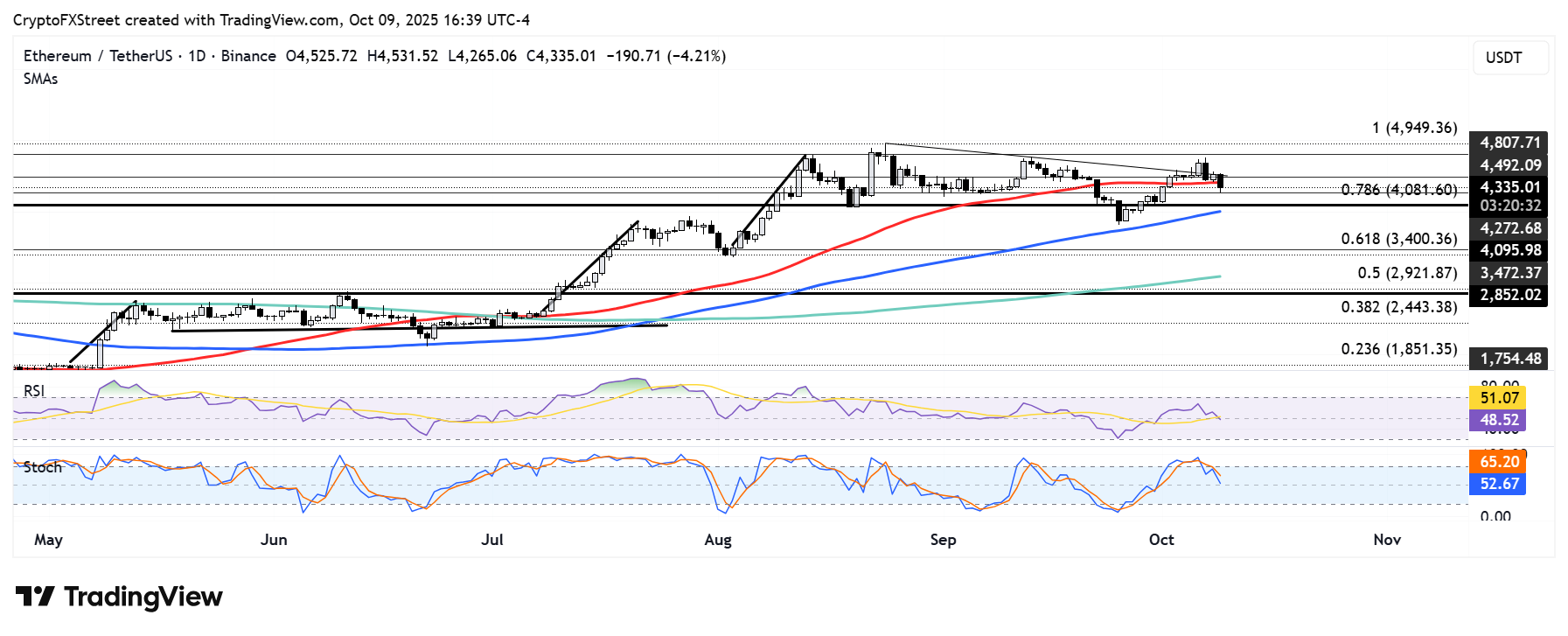Ethereum Price Forecast: ETH dips 4% following heavy distribution from medium-scale holders
Ethereum price today: $4,330
- Ethereum medium-scale holders have distributed over 1.22 million ETH since Monday.
- Investors have booked about $2.5 billion in profits over the same period.
- ETH tests the $4,270 support after facing rejection at a descending trendline resistance.
Ethereum (ETH) declines 4% on Thursday following a 1.22 million ETH distribution from medium-scale holders over the past four days.
Medium-scale holders distribute 1.22 million ETH
After rising toward $4,700 on Tuesday, ETH saw a rejection, dropping nearly 8% over the past three days as prices pulled back toward the $4,300 level.
The decline saw medium-scale holders (wallets holding 1K-10K ETH) initiating a massive distribution, depleting their collective balance by 1.22 million ETH since Monday, according to data from CryptoQuant.
Over the same period, whale wallets holding between 10K-100K ETH grew their collective stash by 200K ETH.
-1760044078653-1760044078654.png)
ETH Balance by Holder Value. Source: CryptoQuant
The move suggests that the recent price drop was spearheaded by profit-taking activity from medium-scale holders.
This is evidenced by the gradual rise in profit-realization over the past four days. Investors have booked nearly $2.5 billion in profits since Monday, per Santiment data. Selling activity was evident across all coin ages, but mainly from short-term holders.
 [21-1760044123092-1760044123093.29.09, 09 Oct, 2025].png)
ETH Network Realized Profit/Loss. Source: Santiment
Historically, pullbacks triggered by medium or small-scale holders often end up as brief corrections if whale wallets continue to accumulate.
Meanwhile, Grayscale accelerated the staking of coins with its spot ETH exchange-traded funds (ETFs) since enabling the feature on Monday, creating further scarcity for ETH. The firm staked 857,600 ETH worth $3.83 billion on Wednesday, according to data compiled by smart money tracker Lookonchain.
Ethereum Price Forecast: ETH tests $4,270 support after trendline rejection
Ethereum saw $181.4 million in futures liquidations in the past 24 hours, led by $152.5 million in long liquidations, per Coinglass data.
After facing a rejection at a descending trendline resistance and falling below the 50-day Simple Moving Average (SMA), ETH is looking to find support around the $4,270 level, which bulls defended between August 26 and September 10.

ETH/USDT daily chart
A further decline could see the top altcoin fall to the $4,100-$4,000 support range, strengthened by the 100-day SMA.
The Relative Strength Index (RSI) and Stochastic Oscillator (Stoch) are declining and testing their neutral levels, indicating a weakening bullish momentum.
Ethereum FAQs
Ethereum is a decentralized open-source blockchain with smart contracts functionality. Its native currency Ether (ETH), is the second-largest cryptocurrency and number one altcoin by market capitalization. The Ethereum network is tailored for building crypto solutions like decentralized finance (DeFi), GameFi, non-fungible tokens (NFTs), decentralized autonomous organizations (DAOs), etc.
Ethereum is a public decentralized blockchain technology, where developers can build and deploy applications that function without the need for a central authority. To make this easier, the network leverages the Solidity programming language and Ethereum virtual machine which helps developers create and launch applications with smart contract functionality.
Smart contracts are publicly verifiable codes that automates agreements between two or more parties. Basically, these codes self-execute encoded actions when predetermined conditions are met.
Staking is a process of earning yield on your idle crypto assets by locking them in a crypto protocol for a specified duration as a means of contributing to its security. Ethereum transitioned from a Proof-of-Work (PoW) to a Proof-of-Stake (PoS) consensus mechanism on September 15, 2022, in an event christened “The Merge.” The Merge was a key part of Ethereum's roadmap to achieve high-level scalability, decentralization and security while remaining sustainable. Unlike PoW, which requires the use of expensive hardware, PoS reduces the barrier of entry for validators by leveraging the use of crypto tokens as the core foundation of its consensus process.
Gas is the unit for measuring transaction fees that users pay for conducting transactions on Ethereum. During periods of network congestion, gas can be extremely high, causing validators to prioritize transactions based on their fees.

